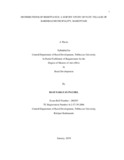Please use this identifier to cite or link to this item:
https://elibrary.tucl.edu.np/handle/123456789/2248| Title: | Distributions of Remittance: A Survey Study of Patu Village of Bardibas Municipality, Mahottari |
| Authors: | Paudel, Ram Narayan |
| Keywords: | Distribution;Study |
| Issue Date: | 2019 |
| Publisher: | Central Department of Rural Development |
| Abstract: | Remittance simply means transfer of money by a foreign worker to an individual/family member in their own home country. Remittance thus has played significant role in the process of micro and macroeconomic development of Nepal. In this background, empirically, this study entitled “Distribution of Remittance: Survey Study of Patu Village of Bardibas Municipality” tried to analyze remittance from microeconomic perspective. In so doing, this study developed some of the specific research objectives such as to examine socio-economic status of the remittance receiving householders, to assess educational and professional status of the remitters and to analyse distributions of remittances in household economy. Methodologically, this study applied quantitative approach and survey research strategy. Required data/information were collected by applying household survey and key informant interview techniques in which survey questionnaires and interview guidelines were used as tools of the study. More specifically, survey questionnaires were filled up by 170 remittance receiving households selected by applying multistage sampling method. And interviews were conducted by six participants (i.e. key informants) selected purposively. Responding to the first objective, the study found that majorities 80 percent respondents have irrigated land but only 20 percent have food sufficiency. Similarly, 57.07 percent respondents are married male but only 20 percent are married female. And 57.06 percent respondents are living with nuclear family and 75.29 percent respondents are receiving remittance from single person. Likewise, most 27.06 percent remitters are working in Qatar and most 50 percent respondents expressed that unemployment is the major cause for foreign employment. Addressing to the second objective, the study found that most 45.88 percent remitters have completed lower secondary level education whereas only 12.94 percent mostly belong to Brahmin/Chhetri community completed Bachelor. Majorities 88 percent remitters completed vocational skills and earning more than those of unskilled. Similarly, 64.27 percent respondents are enrolling their children in private schools and changing their medical services in which traditional healing system is dramatically decreased from 34.11 percent to 8.23 percent. Explaining to the third objective, the study found that most 44 percent remitters earn NRs 35,000 to 45,000 monthly. And 38.24 percent are using banking service while sending remittance in which 31.74 percent remitters are sending quarterly, 8.82 percent monthly and least 6 percent are not yet sending. Likewise, most 28.82 percent respondents used remittance to build house, 34.84 percent are investing in commercial farming, and 21.17 percent are investing in micro entrepreneurship. Similarly, 38.82 percent respondents are also providing donations (philanthropy) in community/social levels and most 41.17 percent respondents are expensing NRs > 40,000 monthly. All in all, this study comes up with the conclusion that remittance in particular help to improve living standard of the remittance receiving households. Even investing trend of remittance in commercial farming, local business, micro entrepreneurship and philanthropy also have been increasing. Therefore, findings of the study can be applied equally in knowledge level, practical level and policy level as well. |
| URI: | http://elibrary.tucl.edu.np/handle/123456789/2248 |
| Appears in Collections: | Rural Development |
Files in This Item:
| File | Description | Size | Format | |
|---|---|---|---|---|
| Ram Narayan MARD Thesis.pdf | 811.25 kB | Adobe PDF |  View/Open |
Items in DSpace are protected by copyright, with all rights reserved, unless otherwise indicated.
